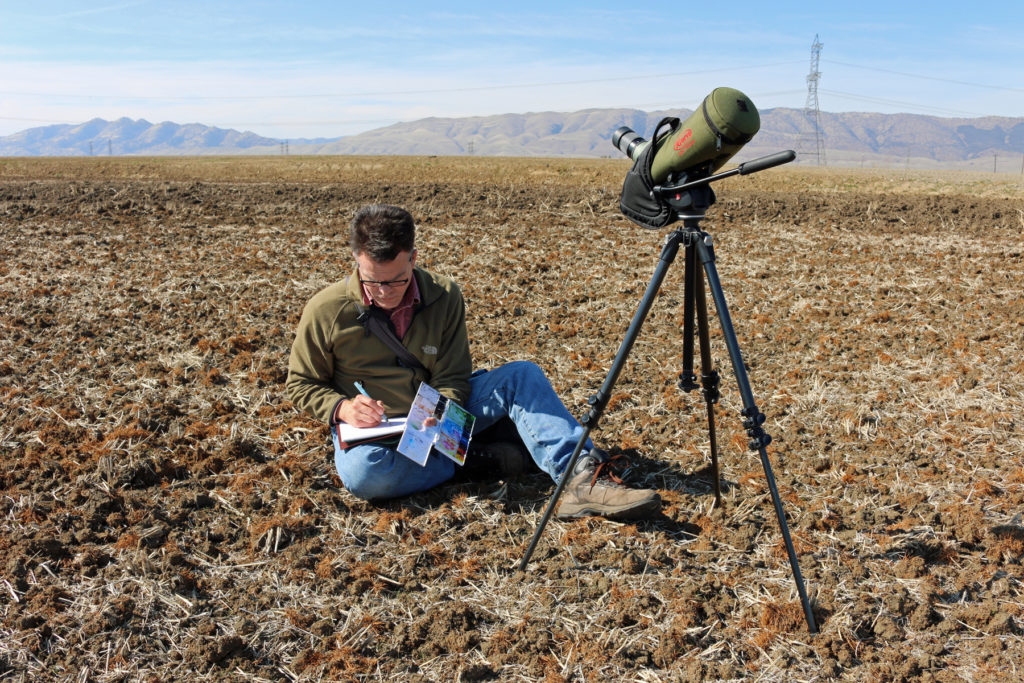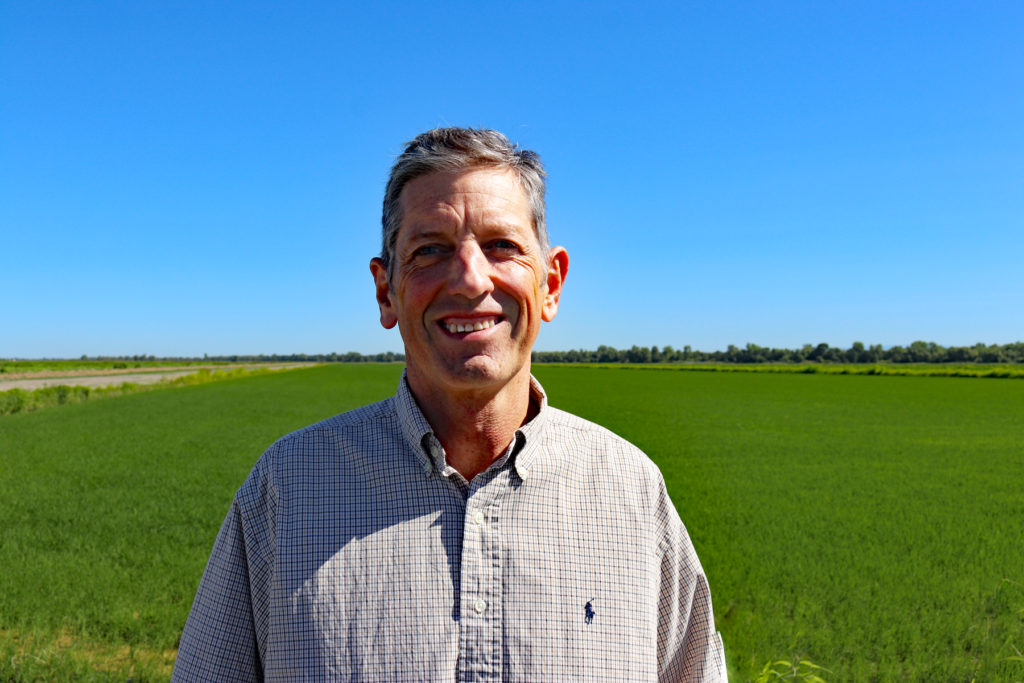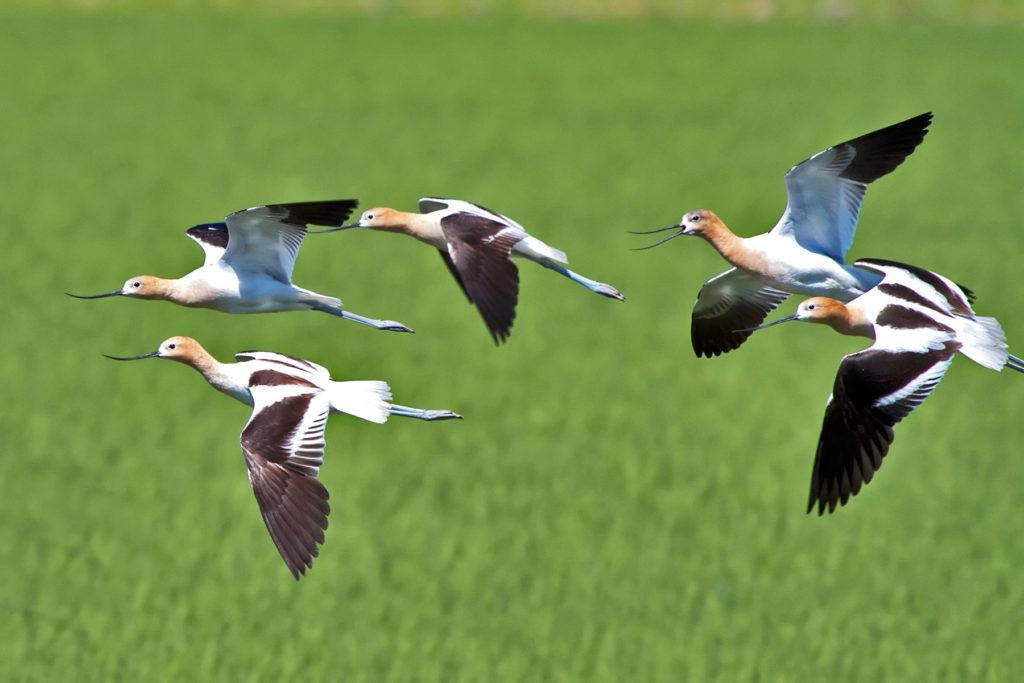The lush green color you see in the Sacramento Valley during summer is from a half-million acres of young rice fields. Those fields are not only beautiful to see, their ecosystem is impressive in its abundance and diversity.

“Rice ecosystems are fascinating marshes maintained by human beings,” said naturalist, artist and educator John Muir Laws. “Many of the birds have adopted these. You look at them – there’s shallow water and green plants growing out of them. That’s a great place to find food. That’s a great place to nest.”
Laws has made several treks to rice country, including with nature journalists, whose artwork chronicling their natural surroundings with enthusiasm, love and creativity. His new book with Emilie Lygren, “How to Teach Nature Journaling: Curiosity, Wonder, Attention,” is another in a long line of informative and inspiring books about our natural world.
Nearly 230 wildlife species depend on Sacramento Valley rice fields for their habitat, and early summer is a critical time for many. Shorebirds such as American Avocets and Black-necked Stilts are nesting and raising their next generation, as they have for generations. Additionally, White-faced Ibis, Egrets, Herons and many other birds are frequently seen and well-fed.

Seeing wildlife is a daily occurrence for rice grower Hans Herkert in Colusa County.
“It may be my favorite part of rice farming is the synergy between the rice farmers and wildlife,” he remarked. His two and a half-year-old daughter, Harper, occasionally joins him in the field and is an expert spotter of Snowy Egrets among the rice plants.
Greg Yarris is Science Coordinator for the Central Valley Joint Venture, a partnership of 19 organizations and agencies to improve bird habitat throughout the Central Valley.
As a biologist, he has a great appreciation for what rice fields provide for wildlife.
“When I see rice fields, I think of birds being fed, especially during the winter. But I also see an extensive breeding ground during the spring and summer. The beauty of rice fields is it provides year-round habitat. During the fall and winter, we get millions of ducks and geese that come down from the north, and during the spring and summer we have local Mallards, Cinnamon Teal and Gadwall that will make this home.”

Yarris said rice is so valuable to wildlife that, in the Joint Venture’s implementation plan, they have a goal to maintain at least 350,000 acres of shallow-flooded rice fields during the fall and winter. Since the vast majority of California’s original wetlands are gone, he said the value of rice fields to our environment is significant. “For us to replace the value of rice with comparable natural wetlands would be extremely difficult and not cost effective,” he said.
There are several programs working to help rice growers maintain or enhance wildlife habitat, including the Regional Conservation Partnership Program, BirdReturns, Bid4Birds and a complementary program with wheat growers.
Here’s a quick look at some of the wonderful wildlife found in rice fields during summertime:
Here’s a link to much more information on wildlife in Sacramento Valley rice fields.
Download Episode
Episode Transcript
John Muir Laws: Rice ecosystems are fascinating marshes maintained by human beings. Many of the birds have adopted these. You look at them. There’s shallow water and green plants growing out of them. That’s a great place to find food. That’s a great place to nest.
Jim Morris: Naturalist, artist, and educator John Muir Laws is passionate about rice farming in the Sacramento Valley. It provides food and a resting place for millions of birds. This time of the year, shorebirds nest and raise their next generation. Come along as we venture to the thriving ecosystem found in California rice fields.
Jim Morris: Welcome to Ingrained, the California rice podcast. I’m your host, Jim Morris, grateful to have worked for 30 years with farmers and ranchers. It’s summer, and one of my favorite times of the year in the Sacramento Valley. You have the rice fields with a lot of color and plenty of wildlife getting food and rest. Here’s more from John Muir Laws on two of the most common and beautiful shorebirds you can find in rice fields right now.
John Muir Laws: The black-necked stilt is a beautiful critter you can find in the rice fields. Bold, contrasting black and white body and incredibly long, bright red legs. And they will hunt by carefully stepping through shallow water and pecking at whatever little crustaceans or other small animals they can see in front of them. So, very, very small food types, so a long, thin, very precise bill.
John Muir Laws: American avocets have a beautiful orange head, soft orange color, and a contrasting black and white body. If you look carefully, you’ll notice that their bill is not straight, but it curves up slightly at the tip. And what they’ll do is they hunt by touch. So, they’ll lower their head to the water surface and move it rapidly back and forth, side to side, side to side, side to side. And where they bump into a small crustacean floating in the water, gobble, gobble, gobble, they nibble it up and then go on to the next one. So, you’ll see them doing this touch feeding as they slowly move forward through the water, their head going back and forth, back and forth in front of them.
Jim Morris: I’m in Colusa County at Hans Herkert’s rice fields. It’s such a peaceful environment out here, Hans. A little breezy today, but very nice. How has this year gone so far?
Hans Herkert: Yeah, good morning, Jim. It’s gone really well so far. It’s been an early season. In fact, this is the earliest season in my short tenure. I believe we’ve just finished planting my eighth rice crop. Started planting in late April and finished on the 21st of May this year.
Jim Morris: So, we’re about a third of the way through the growing season, roughly, and that’ll be a fall harvest. What are some of the things you see in these rice fields besides the plants themselves?
Hans Herkert: Lots of wildlife year-round. This time of year, we’re seeing a lot of killdeer on the rollovers on the levees. They prefer that habitat. We’re some avocets in the fields, some shorebirds, and some ducks, and ducklings this time of year as they’re being weaned up.
Jim Morris: This is all compatible, right? You can grow a crop and also help the environment too?
Hans Herkert: Absolutely. I think it may be my favorite part of rice farming is the synergy between the rice farmers and the wildlife.
Jim Morris: There are conservation programs that help this whole cause. What are some of those that you know and have participated in, and how helpful are they?
Hans Herkert: They’ve been very helpful. I’ve participated in a few, Jim. My first involvement was with a program called BirdReturns, and I’ve also been involved with a program through the Natural Resources Conservation Service. And now, for the first time this year, a great program through the California Rice Commission, Bid4Birds. All three of those programs have been helpful to me as a beginning farmer and helpful to the environment and to the wildlife species that really are thriving out here.
Hans Herkert: I think I could probably say that if those programs didn’t exist, wildlife would still flourish in rice fields. But my opinion of these programs are that they enable growers to enact practices, extend some of the practices that they’re already doing, and enact some new practices on their operations, provide some funds to make it feasible. There’s a certain cost to managing, and pumping water, and maintaining that shallow level of water on the field. And so, if we can manage water earlier in the season and later in the season, on those shoulders of the wildlife season in both the winter time and spring time, that’s really what these programs are enabling us to do.
Jim Morris: I think it’s wonderful to see the nests and to see generation after generation of wildlife out here. Do you have some favorite birds or ones that you see more often out here?
Hans Herkert: I definitely have a few favorites. Great-blue herons are the big ones, and they’re fun to watch. I’ve got a two-and-a-half-year-old daughter, Harper, and she enjoys coming out here. I tell you, she can spot a snowy egret every bit as good as any three-year-old I know. She’s really up to speed on her bird identification, and it’s fun to watch her. We have a lot of bitterns, and they’re not flashy birds, but I tend to like their personality. The American bittern is another favorite of mine.
Jim Morris: And they’re looking at you like, “You don’t really see me. You just think you do.” Yeah, they’re wonderful birds. And I love them too. You mentioned your daughter, and I want to talk a little bit about family. Your dad, Bob, left quite a legacy in California rice. One of the things that comes to my mind is when he brought author, Marc Reisner out to rice country, Marc was not keen on growing rice in California, and after Bob and others visited with him and showed him the rice fields, Marc Reisner thought completely differently and became a real advocate for growing rice. So, tell me about your dad’s legacy and how it may impact your daily work here on the farm.
Hans Herkert: It impacts me greatly. He left such a substantial mark on the rice industry and as on me, as his son, and he instilled his passion for rice farming, the rice industry and how it not only co-exists, but really thrives with wildlife species in the Sacramento Valley as well. And so, the Marc Reisner story is such a great story, and it’s been remembered over the years for a great reason. And I remember being eight or nine years old with both my dad and Marc Reisner driving around the Valley, looking at rice farms and looking at birds. And that’s a memory that I’ll carry forever. And it seems as though it’s made an impact on our industry and rightfully so. I think that the California rice industry has been creating so many benefits, environmental benefits and industrial benefits to the California and the Sacramento Valley that it really just needs to be communicated and learned about. That’s definitely part of my dad’s legacy.
Jim Morris: I’m also visiting with Greg Yarris, Science Coordinator for the Central Valley Joint Venture. And let’s start with the joint venture. What is this effort all about?
Greg Yarris: Well, the Central Valley Joint Venture is a partnership of 19 organizations and agencies that was originally formed in 1988 to improve bird habitat throughout the Central Valley. It initially started as a waterfowl plan focused entirely on ducks and geese, but in the mid 2000s, it expanded its views to try and include other birds such as shorebirds, waterbirds, and landbirds.
Jim Morris: As a biologist, when you’re here looking at these rice fields, what goes through your mind when you see this environment?
Greg Yarris: When I see rice fields, I think of birds being fed, especially during the winter, but I also see an extensive breeding ground during the spring and summer. The beauty of rice fields is it provides year-round habitat. During the fall and winter, we get millions of ducks and geese that come down from the North. And during the spring and summer, we have local mallards, cinnamon teal, and gadwall that will make this home.
Greg Yarris: The flooding of it coincides with the nesting season of our locally-nesting ducks. But what we are lacking are upland nesting areas. So, there’s a couple of programs that our partners have employed to try and improve the upland nesting conditions. One is the Regional Conservation Partnership Program that the California Rice Commission and other partners are working on in cooperation with the Natural Resource Conservation Service. And that will provide thousands of acres of planted nesting cover during the spring and summer to provide that upland habitat for nesting ducks. Another program is a delayed harvest of wheat fields that the California Waterfowl Association has been working on. And what that will do is pay an incentive to farmers who delay the harvesting of their wheat fields to ensure that the duck nests hatch and the ducklings make it to wetlands before the harvest occurs.
Jim Morris: When you say upland, can you just explain from a layperson’s term, what that means?
Greg Yarris: Basically means areas that are not flooded. Traditionally, the Central Valley was a large expanse, combination of wetlands, and uplands, and riparian zones. So, a lot of that has been replaced, but we currently have fewer and fewer upland areas that are maintained as habitat.
Jim Morris: Speaking of historic California and how things have changed, we have lost well over 90 percent of our traditional wetlands. How important are the rice fields, not only now, but moving forward? Because I would assume a lot of those traditional wetlands aren’t just going to magically come back.
Greg Yarris: We have lost, as you stated, over 90 percent of our wetlands, but fortunately, rice fields have replaced what used to be wetlands and provide a lot of the same habitat. They feed ducks during the fall and winter, and geese and shorebirds as well. And they do provide that spring, summer breeding habitat. So, it really is a year-round benefit having rice here in the Valley.
Jim Morris: The joint venture itself is a grouping of individuals and organizations to try to make a difference with our environment. How important is that cooperative work between the growers, state and federal government, conservation groups to maintain and enhance what we’re seeing here in California rice country?
Greg Yarris: It’s extremely important. In fact, in our implementation plan, we have a goal to maintain at least 350,000 acres of rice flooded during the fall and winter. It’s been challenging to try to maintain the current level of flooded rice here in the Valley, primarily because of cost of water, the availability of water, the recent drought that we had, and also, some of the groundwater laws that have been enacted recently. So, the joint venture has worked with other partners to incentivize flooding of rice, especially during the times when we need it most and where we need it most.
Greg Yarris: Some examples of that are the California Winter Rice Habitat and Center program by the State Department of Fish and Wildlife, BirdReturns from the Nature Conservancy, and also the Bid4Birds program that the California Ricelands Waterbird Foundation has recently created. Those are all great methods to try and maintain that level of flooded rice that we have here in the Valley. We also have a goal to provide 50,000 acres of upland nesting habitat on fallow rice fields, primarily using cover crops to enhance not only the soil, but also provide that upland habitat for nesting birds.
Jim Morris: We’ve had another dry year in California, so water use is something that’s on people’s minds. When you look at California agriculture and you assess the value of a crop, how important is it to look at the environmental benefits for rice, not only just the value of rice as a food crop?
Greg Yarris: Well, I think it’s extremely important. Rice does provide other value to the environment, especially for ducks, and geese, and shorebirds. So, maintaining that crop both during the spring and summer for breeding birds, but also having that grain there in the fall and winter when these fields get flooded is extremely important. For us to replace the value of rice with comparable natural wetlands would be extremely difficult and not cost-effective.
Jim Morris: Rice fields benefit many wildlife species year-round, and hopefully those contributions will continue for generations to come. That will wrap up this episode. Thank you to John Muir Laws who does a lot of fantastic work with enthusiastic nature journalists. And he has several excellent books, including his most recent, “How to Teach Nature Journaling: Curiosity, Wonder, Attention”. Go to johnmuirlaws.com to get your copy. And check out his events page. He’s doing a lot of Zoom meetings to provide joy and a creative spark to those at home during this time of COVID-19.
John Muir Laws: Nature journaling is a great way to help yourself get more out of any chance that you get to go outside and look and explore in a natural place. The process of nature journaling helps you slow down, and concentrate, and focus. You’ll get so much more out of each observation that you make. You’re going to find that there are lots of things, even in your refrigerator or the weeds between your house and your neighbor’s house, that can provide opportunities for exploration and discovery.
Jim Morris: Also, big thanks to Hans Herkert and Greg Yarris for their time and passion. You can go to podcast.calrice.org to find out more and listen to additional episodes. We would love to hear your feedback. Thanks for listening.
